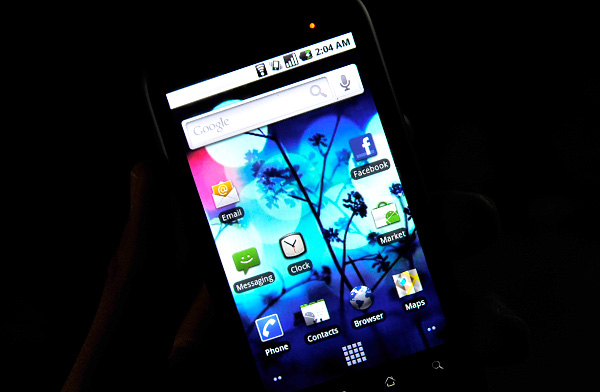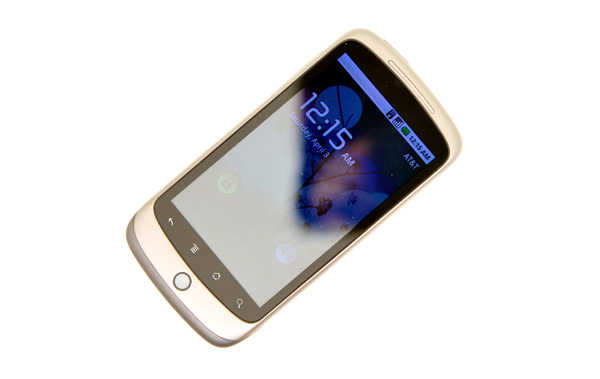Anand's Google Nexus One Review
by Anand Lal Shimpi on April 3, 2010 3:40 AM EST- Posted in
- Smartphones
- Mobile
The Display, My Love, the Display
If there’s one aspect of the Nexus One that makes the iPhone 3GS feel really dated it’s the display. Let’s look at the basic specs:
| Google Nexus One vs. Apple iPhone | |||||
|
Apple iPhone 3GS (ARM Cortex A8)
|
Google Nexus One (Qualcomm Snapdragon QSD8250)
|
||||
| Screen Technology | LCD | Active Matrix OLED | |||
| Screen Diagonal | 3.5" | 3.7" | |||
| Resolution | 320 x 480 | 480 x 800 | |||
| Pixels per Inch | 163 ppi | 252 ppi | |||
For very similar screen sizes (the Nexus One is narrower but longer than the iPhone), Google offers a huge increase in resolution. It makes sense given that the iPhone 3GS is still using the same resolution panel as the first iPhone back in 2007.
Recently Luke Hutchison published an excellent article at Ars Technica explaining the subpixel makeup of the Nexus One’s display. Most display technologies we’re used to reproduce colors by using a combination of red, green and blue. Instead of evenly distributing RGB subpixels across the display, the Nexus One has a combination of RRG or GBB for each pixel. This optimization is put in place most likely to reduce manufacturing cost or increase lifespan of the display.
Either way, you’re not getting complete color data on a per pixel basis. Now I won’t get into the argument of whether or not Google should call it a 480 x 800 display. It technically has that many pixels, it’s just that their makeup is a bit odd.

Google also does some pretty standard tricks to make the display look even more impressive. You get oversaturated colors and the usual trickery you can find in the TV section at Best Buy. Whites on the Nexus One aren't quite white but rather a cool blue and reds are often too red.
Compared to the iPhone, indoors, the Nexus One display is just incredible. If there are two things you could describe the Nexus One display as they would be: high contrast, and sharp. Indoors, and above 50% brightness, it’s honestly the best looking display I’ve ever seen on a smartphone. The colors are ridiculously vibrant and they pop because of the super deep blacks.

It really looks that contrasty.
The AMOLED display has no backlight, and thus it’s far more power efficient to display lots of black than it is to display bright whites. For this reason many of the applications use black backgrounds. For example, here’s the email app in Android vs. the email app in iPhone OS:
|
Google Nexus One
|
Apple iPhone 3GS
|
 |
 |
Given that Android is a fairly mainstream OS and not a pornsite, white text on a black background is generally unexpected. Unexpected, but not more difficult to read. The high resolution and incredibly contrasty AMOLED display make sure of that.

In direct sunlight, the lower part of the picture above is what the Nexus One looks like
Outdoors it’s another story entirely. In direct sunlight, the display is mostly useless at its default brightness settings. With the brightness cranked all the way up it’s still washed out but at least legible. Which brings me to my next point. The auto brightness control on the Nexus One is frustrating.

It automatically adjusts display brightness based on ambient light, but it generally picks a brightness that’s too low for my tastes. I just ended up disabling the automatic control and picked something that was around 50 - 100% brightness depending on what I was doing with the phone. I would like the option to have the auto brightness control pick settings that are a little less conservative.
Touch the Screen
Touchscreens have gotten much better over the past couple of years since the iPhone’s introduction. The Nexus One’s touchscreen is very close to as responsive as the iPhone’s but with some annoying issues. There are some situations where holding the Nexus One in one hand and swiping with my thumb won’t let me swipe between screens, and other similar accuracy issues. Getting the home bar buttons to recognize taps is also a pain at times. The touchscreen is definitely usable, just not as good as the iPhone's.










95 Comments
View All Comments
Johnmcl7 - Sunday, April 4, 2010 - link
Very much agreed, I thought far too much time was wasted on Iphone references which given the Iphone generally does everything worse I really couldn't care less about it. Most noticeably multitasking was only given a brief mention despite being being detailed extensively for the Palm Pre reviews.I didn't understand the complaint about the notifications either, to me as a non-Android user the system makes perfect sense - it seems entirely logical to have icons for each notification which when tapped show a list with text on each one.
John
jamawass - Saturday, April 3, 2010 - link
Great review Anand. do you think the speech recognition worked well enough to be a complete subsitute for typed entry? I've been averse to touchscreen only devices (gave iphone to my wife) because I hate typing on them. Also did you try gesture search which has a highly publicized feature not too long ago?I'm currently using a treo pro windows mobile and even with all it's lack of polish it does feel like I am carrying a portable computer with me. I was hoping Windows7 series would enhance this but it appears as if MS is going to take the Apple approach in this regard. Looks like Android has picked up the windows mobile torch and literally flown to the stars with it.
Sidharthmodi - Saturday, April 3, 2010 - link
I liked the Depth in this Product Review. Thanks Anand.has407 - Saturday, April 3, 2010 - link
Appreciate the depth and that it's based on extended use. Using the 3GS for comparison is spot-on (everything is relative). Thanks again.Chloiber - Saturday, April 3, 2010 - link
Can we expect a review on the HTC Desire or Evo 4G?I know the specs are really quite the same (especially on the Desire) but HTC Sense UI gives the whole thing really a different touch and, according to first reviews, a much better usability.
Anand Lal Shimpi - Saturday, April 3, 2010 - link
We've been trying to get in touch with HTC to get review samples of both of those products. So far we haven't received any response but we won't stop trying :) Worst case, we'll just buy an EVO 4G when it comes out.Feel free to write HTC to provide some encouragement if you'd like :)
Take care,
Anand
Chloiber - Sunday, April 4, 2010 - link
Well, I'm waiting for my desire too :PEvo 4G will probably take even longer....to test Sense UI one can use the HTC Legend, Desire or Evo 4G - shouldn't make any real difference.
Anyway, I'm looking forward to it :)
relativityboy - Saturday, April 3, 2010 - link
If you already have an Android powered phone you can find the Sense UI online, and run it with the appropriate Rom and tools. I just saw it running on a G1 today. It was pretty fast. :)relativityboy - Saturday, April 3, 2010 - link
A very lengthy and thorough review of the bits, but I didn't come away with a solid understanding of how the device fits together as a user experience...the review feels, disjointed.The keyboard is narrow, how does that fit with the voice transcription?
Sometimes scrolling in the 'app drawer' is slow, but what else was going on in the background? Were you pulling data, listening to music, what else was going on in the phone? The device/os is a true multi-threaded environment for applications. I didn't notice any emphasis there (a major win over iPhone).
Did you try doing any benchmarking? Use 'Task Killer' or 'Setcpu'?
Android is OPEN, unlike apple's mobile products.
You can install apps that aren't in the app store.
Memory is super-upgradeable (when was the last time a 4Gb or 8Gb iPhone could be upgraded to 32Gb for the price of a micro-sd chip?)
The comment "It's Mac vs PC all over again" I think is totally missing representing what's going on here. Yet you hit the nail on the head later when you said Apple sees it as a device that's peripheral to laptops/pcs while Google is aiming for what it could be. Apple had a great idea, the iPhone. Google had a great idea a mobile environment/platform to allow lots of people to have great ideas. Google wants to let the world do the creating. The Nexus One as a device is a punctuation mark in a much larger story that includes the G1, Devour, HTC Evo, Droid, and others. Software development kits are available for-free for just about every platform you can shake a stick ate. Google is harnessing the creative powers of everyone who wants to get in on the game... The iPhone is just, well, Apple's 'one thing'.
A very respected developer friend of mine once said, "In a contest between your software/idea and the real world, the real world always wins." Google knows this. Apple doesn't.
I'm definitely an Android person, both by UI preference and ideology, but I don't feel like you've really tried, or given yourself enough time to 'get' what this platform is about.
jasperjones - Saturday, April 3, 2010 - link
Agree that Android's openness is of huge importance. On an iPhone, you can't even install an app that features a woman in bikini, Apple won't allow it. In this context, I always have to think of Tim Bray's statement that"The iPhone vision of the mobile internet’s future omits controversy, sex, and freedom, but includes strict limits on who can know what and who can say what. It’s a sterile Disneyfied walled garden surrounded by sharp-toothed lawyers."